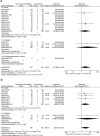Comparison of Hernia Sac Transection and Full Sac Reduction for the Treatment of Inguinal Hernias: A Systematic Review and Meta-Analysis of Clinical Trials
- PMID: 39856021
- PMCID: PMC11903249
- DOI: 10.1002/wjs.12474
Comparison of Hernia Sac Transection and Full Sac Reduction for the Treatment of Inguinal Hernias: A Systematic Review and Meta-Analysis of Clinical Trials
Abstract
Background: The history of inguinal hernia repair has been marked by the description of several therapies over ages, each with its own approach to managing the hernial sac. An analysis of hernia sac transection (with or without high ligation) versus reduction (invagination) in adults who underwent Lichtenstein open tension-free inguinal hernia repair and in adult and pediatric patients who underwent suture repair has been the primary aim of this systematic review and meta-analysis.
Methods: The authors conducted a comprehensive review and meta-analysis. A comprehensive literature search yielded 15 publications, consisting of 12 randomized controlled trials (RCTs) including 1598 patients and 3 controlled clinical trials (CCTs) including 243 patients. In total, the included patients amounted to 1.841.
Results: Analysis of the data revealed a lower rate of recurrence in patients who had sac reduction (0.35% in randomized controlled trials and 0 in clinical trials) compared to patients who had sac excision and ligation (0.86% in randomized controlled trials and 0.93% in clinical trials). However, this difference was not statistically significant (RCTs: relative risk 2.94 [0.30, 29.24]-CCTs: relative risk 4.46 [0.18, 111.36]).
Conclusion: The reduction of sacs does not result in a statistically significant decrease in recurrence compared to patients who underwent sac excision and subsequent ligation. This study has demonstrated that the various courses of treatment for the inguinal hernia sac have similar primary and secondary outcomes in both adult and pediatric patients.
Keywords: hernia sac reduction; hernia sac transection; inguinal hernia.
© 2025 The Author(s). World Journal of Surgery published by John Wiley & Sons Ltd on behalf of International Society of Surgery/Société Internationale de Chirurgie (ISS/SIC).
Conflict of interest statement
The authors declare no conflicts of interest.
Figures












References
-
- Shulman A. G., Amid P. K., and Lichtenstein I. L., “Ligation of Hernial Sac. A Needless Step in Adult Hernioplasty,” International Surgery 78, no. 2 (April‐June 1993): 152–153: PMID: 8354615. - PubMed

